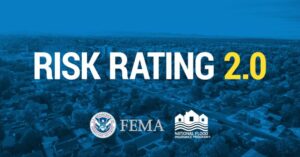When the Federal Emergency Management Agency unveiled its new Risk Rating 2.0 methodology for calculating flood insurance, advocates and critics alike warned that it would mean higher premiums for thousands of property owners, especially in low-elevation coastal areas.
Now, the full impact of the sticker shock is becoming clear, thanks to new data released by FEMA that shows price increases – and decreases – by county and by ZIP codes. For some parts of Florida, including the appropriately named Hell Gate on the East Coast, flood insurance will spike an average of 342%, according to the Miami Herald, which analyzed some of the data.
The most expensive ZIP codes in Florida include the Miami area’s Key Biscayne, which will eventually see flood rates as high as $7,000 annually, on average, the Herald reported.
Most ZIP codes across the Southeastern U.S. will see some increase, the data show. In parts of Pensacola, in the northwestern part of Florida, the average flood premium will double, from $639 annually to $1,293. In Houma, Louisiana, southwest of New Orleans, the average premium will jump from $982 per year to $3,511.
And it’s not just coastal areas. Albany, Kentucky, ZIP code 42602, which has seen historic flooding in recent years, will see prices soar — from $741 to $4,597, on average, the FEMA data show.
But some spots will see decreases under RR 2.0, which is based less on FEMA’s much-criticized flood maps and more on a multitude of factors, including rainfall levels, elevation, a home’s distance from water, and rebuilding costs. In one St. Petersburg ZIP code, for example, more than 80% of policies will see a decrease in premiums, the data show.
Existing property owners won’t feel the pain all at once. Federal law limits the rate increases to no more than 18% annually on renewals. For people buying new policies, though, the full impact will be painfully obvious. For the past year, FEMA has required new policies to be rated under RR 2.0.
 Even before the FEMA data was broken down by ZIP code, some insurance agents have had a pretty good idea of the magnitude of the changes. For one policyholder in a flood zone in Palmetto Bay, Florida, his annual premium will eventually climb from just over $1,000 to almost $5,000, said Clayton Fischer, an agent with Blue Marlin Insurance in Coral Gables.
Even before the FEMA data was broken down by ZIP code, some insurance agents have had a pretty good idea of the magnitude of the changes. For one policyholder in a flood zone in Palmetto Bay, Florida, his annual premium will eventually climb from just over $1,000 to almost $5,000, said Clayton Fischer, an agent with Blue Marlin Insurance in Coral Gables.
For a modest slab home in Homestead, Florida, with 1,700 square feet and a replacement value of $271,207, a policy through Wright Flood Insurance will come to about $2,300.
“I have found private carriers to be not only competitive but, in some cases, more competitively priced than the NFIP RR2.0 policies,” Fischer said.
He also noted that some prospective home buyers may not be aware of the soaring premiums. If the seller doesn’t explain about the new rating system, which grandfathers in existing owners, buyers could easily assume that their rates will remain the same.
Florida homeowners with Citizens Property Insurance Corp. also will see significantly higher premiums this year. The Florida Legislature late last year required that all Citizens policyholders to buy flood insurance, regardless of the property’s locale.
The FEMA spreadsheet with all U.S. ZIP codes can be downloaded here.
Photo: People try and save valuables in a Fort Lauderdale neighborhood after torrential rains in April (Joe Cavaretta/South Florida Sun-Sentinel via AP)
Topics Flood
Was this article valuable?
Here are more articles you may enjoy.



 4,800 Claims Handled by Unlicensed Adjusters in Florida After Irma, Lawsuit Says
4,800 Claims Handled by Unlicensed Adjusters in Florida After Irma, Lawsuit Says  Former Congressman Charged After Collision with State Trooper in Florida
Former Congressman Charged After Collision with State Trooper in Florida  Progressive Gains as Drivers Shop Around for Auto Insurance—Again
Progressive Gains as Drivers Shop Around for Auto Insurance—Again  South Carolina Ringleader Sentenced to 8 Years for Staged Accidents
South Carolina Ringleader Sentenced to 8 Years for Staged Accidents 


